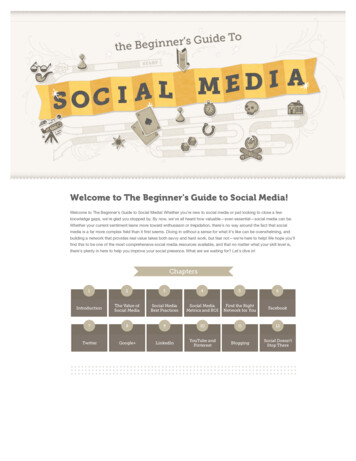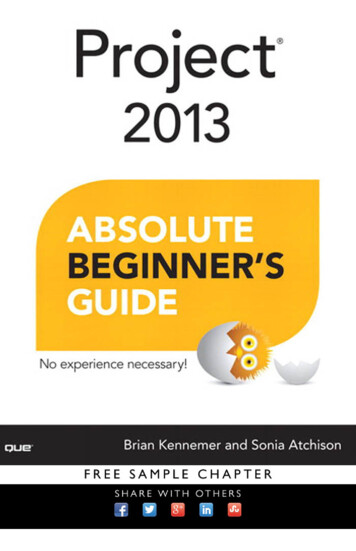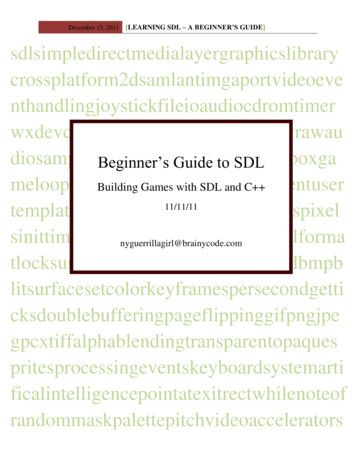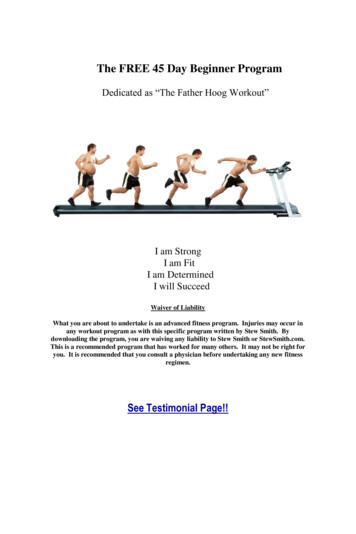
Transcription
Welcome to The Beginner's Guide to Social Media!Welcome to The Beginner's Guide to Social Media! Whether you're new to social media or just looking to close a fewknowledge gaps, we're glad you stopped by. By now, we've all heard how valuable—even essential—social media can be.Whether your current sentiment leans more toward enthusiasm or trepidation, there's no way around the fact that socialmedia is a far more complex field than it first seems. Diving in without a sense for what it's like can be overwhelming, andbuilding a network that provides real value takes both savvy and hard work, but fear not—we're here to help! We hope you'llfind this to be one of the most comprehensive social media resources available, and that no matter what your skill level is,there's plenty in here to help you improve your social presence. What are we waiting for? Let's dive in!Chapters123456IntroductionThe Value ofSocial MediaSocial MediaBest PracticesSocial MediaMetrics and ROIFind the RightNetwork for YouFacebook789101112TwitterGoogle LinkedInYouTube andPinterestBloggingSocial Doesn'tStop There
Chapter 1IntroductionWhat is social media?"Social media" is a way for people to communicate and interact online. While it has been around since the dawn of theWorld Wide Web, in the last 10 years or so we've seen a surge in both the number and popularity of social media sites. It'scalled social media because users engage with (and around) it in a social context, which can include conversations,commentary, and other user-generated annotations and engagement interactions.Publishing content has become exponentially simpler over the last several years, which has helped skyrocket the use ofsocial media. Non-technical web users are now able to easily create content on a rapidly growing number of platforms,including those that are owned (hosted communities, blogs, etc.), rented (social networks or third-party communities), andoccupied (commenting, contributing, etc.). Today's web has shifted from a "one-to-many" to a "many-to-many" method ofengagement, and we're loving it.For businesses, the shift in web consumerism and accompanying rise in social media brings both opportunity andresponsibility. The sheer amount of data that customers make available through social media alone has web marketersjumping for joy. The real magic, however, lies in the opportunity to grow lasting and scalable relationships with yourorganization's customer base through social media. This is also where your online responsibility to your customers begins totake shape. Just as your customers' behavior has shifted, so have their expectations for yours. Whether your business islistening and engaging or not, customers are having conversations relevant to your operations. It's better to be part of theconversation, right? We sure think so!
Is social media just a fad?Over the last several years, there has been an explosion of growth in popular social media platforms like Facebook, Twitter,Google , LinkedIn, YouTube, Pinterest, and many others. It's safe to say that the era of social media is just getting started,and the need for social media in business will only become stronger over time. The whole world has seen the impact of theexpansion and adoption of social media tactics, and the rising stats speak for themselves.
Why does my company need social media?Whether you are running a small, local operation, or heading a global, enterprise-level effort, the statistics above make itclear: Your customers are online. They are interacting in social channels with their friends, colleagues, and other brands insearch of information, recommendations, and entertainment. If your company is not around to answer, a competitor will be.In doing so, your competitor will quite likely take away the customer at hand, along with anyone else listening.There are tons of opportunities to add value—even to delight!—and making that connectioncan help build a person's relationship with acompany, brand, or representative. Thoserelationships create the foundation for what caneventually become one of your greatestBecause so much of the customer experiencenow lives on the web, social media enablesbrands to take part in a customer's onlineexperience outside of the typical channels.marketing assets: customer advocacy.If you ever find yourself in a bind, your advocates will help remind the rest of theworld who they're rooting for. Advocacy is not something that you can stumbleupon or buy. Advocacy is earned over time through continuous and positiveengagement with your customer base. It is earned through experiences thatdelight, and through the delivery of the highest class of customer service.Advocacy is the nirvana of social media, and it is through advocacy that your efforts start totruly scale and grow. It shows that your brand is doing such an amazing job that your customers shout about your brandfrom rooftops, sharing their opinions and experiences with their networks. That sharing is the best marketing a brand canask for.Identifying potential advocates is a good first step. You can use social tools (many of which are outlined in the rest of thisguide), site data, customer data, and even your own observations to help you pick out which customers are likely to go tobat for your brand. You'll want to figure out what is most important to those potential advocates. What are they looking for?Are they fishing for recognition? Are they excited by exclusive access to news and/or content? Figure out what type ofadvocates your brand attracts and find ways to recognize them for their advocacy. It is important to note, though, that mostof your greatest community relationships will be built organically. While your research and brand knowledge encouragespeople and helps you put the right foot forward, relationships take time.The transition from a passive web to an interactive web has brought with it many changes affecting how individuals connectwith one another and also how businesses operate. At this stage in the game, it's fair to say that a web presence is critical tothe success of a business. You can't get ahead if you're ignoring your customer's online conversations or opting to look the
other way. Use this opportunity to get closer to your audience than ever before—reach more people in a genuine andauthentic manner, drive more qualified site traffic, increase the authority of your brand, engage the people who influenceyour customers' behavior, and gain the data necessary for insights-based business decisions.Maybe a better question is, why wouldn't your company use social media?How can social be a springboard for successin other marketing channels?Keep in mind that neither your customers' experience nor your brand starts with Twitter, Facebook, or your blog. Socialmedia should take your existing brand and solidify it, galvanize it, and bolster it. Your efforts in social media should be anextension of everything else you do in all departments of your company. Capturing your company's voice and sharing it withthe world through social media will open up unique opportunities in all other channels of inbound marketing, including SEO,branding, public relations, sales, and more.RelationshipsTo get the most out of social media, make the relationships you build with it yourend goal. That might sound a bit utopian for anyone who is grounded in moretraditional and tangible business measurement and metrics, but take a step backfrom the bottom-line, ROI-seeking aspect to look at the big picture for a minute.The relationships built with customers are the foundations upon which otheraspects of your business can and will flourish.Relationships flourish when you cultivate them, and no other area offers you theopportunity to do this as well as social media. Social channels have broken downthe walls between individuals at an unprecedented rate. In 2011, Facebookreleased data showing that its users were, on average, 3.74 degrees of separationaway from one another, making them nearly as connected to each other as KevinBacon is to the rest of Hollywood. In the years since that study, the network hasonly continued to grow. That's pretty amazing, and social media can take credit formaking it happen.Some of the most successful SEOs and public relations professionals earn theirnotoriety, at least in part, from the relationships they are able to build. They're alsogood at what they do, of course, but great relationships bolster their already solideffort. The relationships you build with your customers lead to advocacy andloyalty, traits that can support your brand during both the good and the bad times,representing an investment that will remain strong on nearly any platform andunder nearly any circumstances.FeedbackInformation can be shared through social media at an amazingly fast pace, andusers are increasingly turning to social channels to share information in realtime. This information often takes the form of opinions, so if you're listening forthe right cues from your audience, social media can become an invaluablesource of insights and feedback. Incorporating social listening into productdevelopment work can act as an early warning system, save on customerservice costs, provide valuable development feedback, and even help identifyideal beta testers without much expense.IntegrationSocial media is not something you can simply "tack on" to the rest of your marketing, branding, PR, and advertising efforts;it needs to be a fully integrated part of the mix. In doing so, you can create a cohesive and scalable experience for yourcustomers. Think of it as a means to an end, and not an end in itself. Also, it's not as hard as it sounds.Be sure to integrate social media into your marketing efforts as early as possible to help amplify and solidify your work rather
than waiting until the end of a planning cycle to explore social options. If a socialpresence is clear from the start, your branding will benefit from additional customertouchpoints, PR will see a lift in impressions and reach, and customer service canproactively listen and activate where necessary.As you can see, a social presence can have far-reaching impact for yourorganization when it is executed in an authentic and thoughtful manner. By makingsocial engagement a core part of your operations rather than an afterthought, youhave a better shot at fully leveraging its power.How much of this guide do I need to read?As you can probably already tell, there's more to social media than often meetsthe eye. While this guide is designed to be helpful no matter how much you read,we really recommend going cover to cover. Although every section might notapply to your social campaigns now, you'll gain a deep understanding of themoving parts you might want to implement later, and you will be well-poised tocreate the most effective strategy you can.If you'd rather print it out and take it with you, we have a handy-dandy PDF ofthe entire guide available for you to download.
Chapter 2The Value of Social MediaBuilding and engaging a communityPerhaps the greatest value of social media marketing is your ability tofoster and engage with a community of other people. That engagementis at the heart of social media, and without it, you're left with amegaphone and no one to hear you. You have the opportunity to interactwith customers from all over the world—including those who are rightdown the street—on a huge scale. If a current or prospective customerhas something to say to you or about you, you now have the ability torespond immediately.In addition to responsive communication, brands and businesses canbegin to build relationships with their customers beyond those thathappen during normal transactions. These relationships are what keepcustomers coming back, increasing both loyalty and retention. If thosecustomers become advocates and increase your word-of-mouthpresence, you'll start seeing amazing returns.By providing a great place of engagement for your community and helping build valuable, authentic resources for yourbrand's niche, you're also building up authority for your brand within your industry. You'll find your customers increasinglytrusting what you say and coming to you for resources that can help them solve their own challenges. Heck, you may evenfind yourself lending a hand to a competitor in the space. All brands start in a similar unknown place, and the more you give,the more authority you'll get back. A great example is REI, which not only sells outdoor gear, but is also a known resource fortips on hiking, snowshoeing, zombie survival, and a whole host of other activities centered around the outdoors.Moving from "like" to "love" to "defend"The feelings of any community member toward your brand can range from resentment to adoration and beyond. We'lladdress the negative feelings later on; the people we want to concentrate on now are those we hope to move along aspectrum from simply "liking" you all the way to being willing to defend you and your brand.The first step is getting people to simply like you, whether on Facebook, by word of mouth, or however. The people who likeyou are consistently having their expectations met. This typically feels transactional with a low level of engagement, thoughthere's certainly nothing wrong with that.Like any relationship, forming bonds that take you to the next level highly depends on the needs of both your brand and theindividuals with whom you're interacting. You want to form these bonds on positive experiences you have together thatbenefit both of you. (This is not to say that bonds can't be formed through adversity, but having say a positive Twitterexchange around helping someone is better than one around how your product is malfunctioning.) Even better if theseexperiences bring delight and build your unique brand voice. For example, when Kotex started their Pinterest account, theyselected 50 female users and sent them unique packages based on their Pinterest boards. Not only were these womensurprised and happy, but all shared about what Kotex did on their social networks, creating a cascade of warm feelings.
There is another level where this relationship grows even deeper. When a customer becomes willing to defend your brand,you know you've really outdone yourself. This final "willingness to defend" stage is brand and social nirvana, as communitymembers are not only engaging frequently and providing recommendations, but also standing up to advocate your work anddefend you from brand detractors.You can never expect your community to handle 100% of the customer service issues or questions that arise. They aren'tfully equipped, and it's not their job. But you can expect, after your initial investment and cultivation, that some communitymembers will begin to step up and help out when they can and where appropriate. (This is a good time to think about abouthow to recognize and even reward your most active participants.) When that happens, you begin to see how your efforts willstart to scale as you continue to boost your community engagement efforts. It frees you up to work on other engagements,and as you might imagine, an advocate standing up for a brand is far more powerful than a brand standing up for itself.There's a level of authenticity built into that sort of peer-to-peer interaction that can't be found in brand-to-customerinteractions.It's not just about marketingThe community engagement that social media affords is beneficial to nearly every part of your organization, from the productteam to HR and more. As an added bonus, getting more colleagues involved will lighten your load. To get you started, hereare a few areas that see the most obvious value.Content creationBy using your search traffic data, on-site engagements, and social listening efforts, your social media presence can help youdetermine what people are looking for and create content that fulfills their needs. (Not to mention giving you a wonderful wayto share that content once it's available.) Topics for content will likely fall in one of three buckets:Learn and improveThis type of content is designed to optimize your customers' tasks or workflow. You are attemptingto make their lives better by more fully utilizing your product (feature education, etc.), or even byoffering assistance. The main goals of this content type are to build authority, drive connections,and increase engagement.Explore and discoverCustomers wanting to get creative and find new ways to use your product are looking for this typeof content. For this group, building relationships is going to be tantamount; these relationships willbreed ideation and community.Question and answerThis type of content serves to meet customer support needs. Something has gone wrong, andcustomers seek a solution. This can range from a detailed forum thread on resolving a technicalissue to a simple question and answer on how to make a product return. Your main goal is to driveanswers.Also, don't overlook the content that can be generated within your own community. User-generated content can be amazing—a gift, even! Your users can help write what your audience finds interesting, relevant, and useful. The possibilities areendless.Using analytics tools like SimplyMeasured, True Social Metrics, as well as tools from the networks themselves, you can
measure the conversations you’re having on Twitter, Facebook, Google , and even YouTube for content creation ideas. Thebig takeaway: Members of your community are openly talking about what they want. In order to reap the benefits of thatconversation, all you need to do is listen. It's remarkably easy to derive meaningful insights when you're looking in the rightplaces.Customer serviceIt's a pretty natural human reaction to complain when something doesn't go our way. In the past, we might simply havevented our frustration to a couple of friends. Now, we turn to Twitter and Facebook. A much larger audience is listening there—one that is not limited by geography and has the ability to easily amplify any complaints. As a company, when individualsuse their social channels as a means of complaining about you, it can be frightening at first. It can feel like you're beingattacked and like you have no control. But these truly are opportunities to jump in and help rectify the situation, evenimproving the customer's experience with your brand.Bottom line: We're rising with the tide of ourcustomers' expectations.Not all customers will address you directly, however, so it helps to belistening. Always make sure it's clear and easy for people to easilycontact you. It may help prevent a Twitter rant or an upset Facebookupdate.Some customers out there are ready to engage with questions, concerns,and even complaints, and it's your job to be there. But you don't have todo it alone. Remember that as you move your community members intomore meaningful relationships with your brand, they'll stand up to defendyou. You have to put in the muscle up front, but after a while, you'll startseeing evidence of your community stepping in to help each other onyour behalf.With some training and an emphasis on consistent voice, social participation can be picked up by other customer serviceoriented departments inside the company. When social engagement is not the sole responsibility of a social media marketingprofessional, but rather a distributed effort across functional areas of the company, you'll be able to better serve yourcustomers while running an efficient and informed business.Product developmentAt no other time in history have businesses had more access to customers at scale than they do now, and productdevelopment stands to benefit from this perhaps more than any other group. Input from social media, though, can be both ablessing and a curse, as people don't always know precisely what they think or want. There's a quote widely attributed toHenry Ford, founder of the Ford Motor Company, that goes, "If I had asked the people what they wanted, they would havesaid faster horses."
It's easy to make the mistake of treating all customer input as gospel. Feedback is incredibly important, but that being said,you should take that feedback in the context of everything else you know about your product and your brand. A fewcomplaints are not necessarily representative of your entire userbase, so the feedback you're seeing may not be completelyrepresentative of the truth. There are several tactics you can employ to make sure you're gleaning all the right benefits of thiscustomer feedback without assigning artificial weight.Create beta/tester communities: This can be done in a couple of ways. You can curate a list of communitymembers who would be most helpful—power users from across the social web, enthusiast bloggers, and so on—into agroup connected by email, a Facebook group, or other social mechanism. You can also create special restricted areas ofyour forum-based communities where these power users can converse, engage, and network while participating inconversations you generate. This special access can serve as a reward for those community members, and it can lead toincredibly useful insights for you and your brand.Listen for your competition: As you listen for product feedback, you'll want to analyze sentiment, look out forspecific problems, and see what the greater community says about your competitors. Conversations happening around yourcompetition's products/offerings can provide endless amounts of insight for your own efforts.Measurement: Just as you can glean insights about your products by sifting through your web analytics, you can gainsimilar clues by watching and measuring the performance of your social channels. Do posts about one product frequentlyoutperform similar posts about another? Your customers might be telling you something about which they like better.Human resourcesSocial media can play a wonderful role in HR, as well: encouraging employee engagement, finding and connecting with newrecruits, and even helping with retention efforts.A word about governance: Depending on the culture at your organization, your HR departmentmight need to play a part in any implementation of social media, and regardless of the culture,getting their buy-in is always a good idea. Working with your HR professionals during thedevelopment of your social media policies and governance can help ensure your organization isprotected from risk while empowering its employees. Definitely get in touch with them beforepulling other employees into your efforts; this is one area where you'd rather ask permission thanforgiveness.Beyond those governance considerations, though, socialmedia can be a remarkable tool for HR professionals. Someof the areas you may be able to grow your efforts into HRinclude:
RecruitingSocial channels are the perfect placeto reach new applicants. Peoplesearch for job openings online, andchances are that some of them havealready "liked" you, so why not reachthem where they're already spendingtheir time? Given its interest, yourcommunity will also be more apt toshare these openings with itsnetworks.Internal social networkingThere are some social networks that are designed to be usedentirely inside an organization. Some people like Yammer.Some prefer Chatter. Heck, some even use Basecamp or Jive.Whatever flavor you pick, social networking tools usedinternally can be incredible for knowledge sharing, building asense of camaraderie, and increasing cross-functionalcollaboration. Internal social networks can also be valuable forgovernance and policy awareness efforts.Career advancementBeing active and fully aware of the "hows and whats" of socialmedia is quickly becoming a mandatory skill in today'sworkforce. This skill cannot be overlooked, especially for HRprofessionals. Social media can also be used to networkonline and learn about trending topics in a specific field,discovering new areas of opportunity for the business thatmight include niche communities for related professions.Social media is not something that should be solely utilized by any one team within a company. Ideally, the entire
organization is involved in some facet of the company's social media and has a deep understanding of their customersthrough participation. Cross-functionally distributing the social media effort also helps ensure the right people take the helmat the right time.At the same time, it's important to maintain consistent voice and branding for every aspect of your company's social efforts,so you'll want to at least create a set of basic guidelines for everyone involved.Wow, impressive. I'm a marketer, though—what does all thismean for me?As more people throughout your organization realize the benefits they'll receivefrom social media, you'll be better able to focus your efforts on marketing insteadof on being a help desk or a go-between. Additionally, you have the added benefitof scaling some of the costs associated with social engagement, and you willhave multiple teams of people on your side helping to make the business case forinvestments in engagement evolution rather than going at it alone. This is afoundation for success.How to get social media buy-inAs you make your case for your brand's social media endeavors, you'll likely need to show value to your leadership orclients. The good news is that with a little analysis, the data is on your side. Let's start by building a business case that'sright for you.You know your organization better than just about anyone, so trust your gut. If you're worried about pushback, you can runsome small-scale tests to see how it goes and build a case for your effort. In safe pockets—places where you can playaround and create the foundation for your business case without much risk—build out a trial or two that touch on some ofthe most pressing issues your organization faces, and see if you can't prove the impact of social media in those areas. Youmight even look to your competitors for some good examples. Once these tests have yielded results, present your new datato whomever needs to give the social sign-off. This strategy of starting small helps buy you the permission and trust you'llneed to work towards some of the more difficult results.
If you have tried making a business case and you're still being met with resistance, don't give up. Try building out specificcase studies to add substance to your pitch, giving higher-ups a feel for what it will eventually look like. If you have anopportunity to start small, dipping a toe in the water with minimal risk, your results can speak volumes. Once you havesomething new to show, you can revisit and strengthen your business case. It's hard to argue with data.
Chapter 3Social Media Best PracticesWhat kinds of content to publish and shareA common (and understandable) mistake that many people make as they're diving into social engagement is to limit theircontent to promotional updates. This is reflective of the traditional marketing world in which all outbound push messaging isjust that, but things have changed; now we build our marketing efforts on trust, engagement, and community.There is, of course, a time and place for marketing and promotional messages, but don't limit yourself. Consider broadeningyour scope a bit. This will make your content more appealing and lessen the burden of creation. Some options for types ofupdates may include:Adjacent content: It's a pretty safe bet that if someone is following you they're interestedin what you offer. It's an even safer bet to say their interests don't stop there. Share content that'stangentially relevant to your business or something involving common interests of your audience.For example, if you are a clothing retailer, you could post about up-and-coming beauty trends ornews from a major designer. These topics quite likely directly align with the interests of youraudience.Tips and tricks: Addvalue to the conversation bysharing content that will make yourcustomers' lives easier (bonuspoints for tips and tricks that helpthem use your products orservices).Responses: Not every update has to stem from original ideas of yours; you can bounce offthe ideas that other people are already posting. Social media relies on conversations, so jump inand be a part of them. You can even look for Twitter chats that are relevant to your brand and divein. (This is also a good way to get your account and brand more visibility.)Non-promotional company information: If your companydoes amazing volunteer work in your community, don't be shy about sharing it! Ifthere's a rather impressive showing at the company Halloween party, you definitelywant to share that. Giving a sneak peek into the culture and community within anorganization goes a long way to building relationships by humanizing the brand. Socialmedia provides a fantastic way to go about this.
Job openings: Social channels can be an incredibly fruitful place to find new talent andpublicize job openings. Job seekers are increasingly using social media as a way of learning aboutcompanies and their open positions; it's a match made in Internet heaven. Get those listings outthere and be sure to highlight the most important ones.Jokes: This is a tricky one, and it's more of a brandingquestion than anything else. First of all, know what yourbrand is and what kind of personality it embodies. If humoris not a part of that, you might avoid this type of post. It canbackfire and be incredibly awkward. If you are going to tryhumor, safety first! Ensure you're not unintentionally sharingsomething that could be offensive by testing it amongst yourcolleagues, friends, or even family. Always err on the side ofcaution with sensitive topics; a disaster can be really painful.Once you've made sure the humor is acceptable, make sureit's actually funny, because a bad joke is just embarrassing.How to share and publish your contentFrequency of updates"How often do I need to update my a
"Social media" is a way for people to communicate and interact online. While it has been around since the dawn of the While it has been around since the dawn of the World Wide Web, in the last 10 years or so we've seen a surge in both the numb











